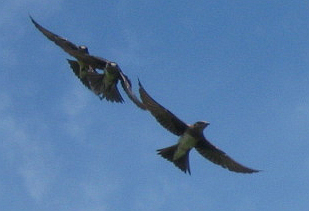Any day now, the purple martins will vanish.
They might even be gone now. I mean, they arrived at their pole-top summer house near the baseball field in the Unity park around the end of April, as usual, squawking, chattering and getting the nests ready. They winged through summer domestic life in May, June and July as always and, as always, will take off for winter around now.
My first sighting this year was April 29. I missed the “scouts” — seraphic older birds that every year arrive earlier than the rest, like the first flickers of light, to see if anything changed in the vicinity of the nest over the winter. They always come back to the same spot if they can, unless the nest site has deteriorated, the water supply dried up, or obstructions to their glinting aerobatics have popped up, such as buildings or sudden growths of poplar. It helps if there’s no immediate threat from starlings or house sparrows, either, who will knock eggs out of the nest to crack them open and even kill adult martins.
No such bad luck at the Unity Field of Dreams, though, where “site fidelity,” as it’s called, is good year in and year out. They rebuild the nests in the four-story condo there and tend four or five white eggs.
Not too long after hatching, little cherubic faces can be seen waiting eagerly in the windows. The parents make energetic forays alone or in pairs to snatch insects out of the air and return to feed the chicks.
The chicks seem to fledge in July and get in some practice flying, and then the whole flock one day in early or mid-August sets off, some flocks joining larger ones, and heads south for winter homes, some deep in South America. It is apparently not well known exactly which flocks fly how far south.
Purple martins are the largest dominion of swallows in our sky. Their relatives are barn swallows (with rusty orange bellies), cliff swallows and tree swallows. They’re exceptionally gregarious, and how many martins will fit on the head of a birdhouse depends mainly on the size of your imagination of a residence. Audubon says they can be attracted to dwell in anything from a one-room efficiency to a 200-unit complex.
People have been cheered by purple martins for literally time immemorial. The early European settlers noticed that the Indians put gourds on tall poles around their gardens for the martins to nest in, and they imitated the practice by constructing their own birdhouses like a sort of prayer for help from the martins to come clear the air of flying demons such as midges, flies, wasps and mosquitoes.
And they do it with Blue Angel deftness. They turn, twist, dive and climb in extraordinary improvised dances on the very air. They buzz down like avengers if you get too close to their digs. They chatter together with tremendous energy in some kind of celestial glossolalia on wing and roost, and when the sunlight strikes their dark-blue feathers, their heads burn with a blue iridescence. Their point-tipped wings in flight look like the gear of aerial spirits, and on a perch fold into upthrust shoulders like ancient depictions of angels. Which came first, the angels or the martins? I’m not sure.
Anyway, it’s their time to disappear again, as if crossing over into another, southern dimension with that eternal, gorgeous here-and-goneness.
Dana Wilde lives in Troy. His writings on the Maine woods are collected in “The Other End of the Driveway,” available from Booklocker.com. Backyard Naturalist appears the second and fourth Thursdays each month. You can contact him at naturalist@dwildepress.net.
Send questions/comments to the editors.





Comments are no longer available on this story